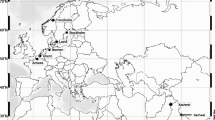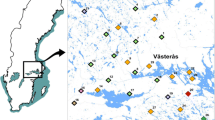Abstract
While there is evidence that the genetic structure of invasive populations may be distinct from native populations, it has proved difficult to establish the causes of any variation owing in part to the range of evolutionary processes involved. In order to assess differences in the genetic structure of invasive populations of Gunnera tinctoria, five native populations were compared to 23 geographically widely dispersed invasive populations using amplified fragment length polymorphic markers (AFLPs). In total, 221 individuals were sampled at three spatial scales: inter-regional, within-region, and at a high-resolution local scale. It was observed that there were high levels of genetic variation between most populations, that invasive populations were generally distinct from both native populations and from each other and that genetic variation away from founding populations can occur relatively quickly and within a small geographic area. Changes in the pattern of genetic variation observed in invasive populations strongly indicated that founder effects and genetic drift played a significant role in shaping their genetic structure. It was further concluded that gene flow had a homogenizing effect on the structure of invasive populations occurring in close proximity, increasing their allele content and potentially contributing to their successful establishment.




Similar content being viewed by others
References
Allendorf FW, Lundkvist LL (2003) Population biology, evolution, and control of invasive species. Conserv Biol 17:24–30. doi:10.1046/j.1523-1739.2003.01717.x
Armstrong C (2008) Development of control measures and distribution mapping of Gunnera tinctoria on Achill Island, Co. Mayo, Ireland. Dissertation, University College Dublin
Armstrong C, Osborne BA, Kelly J, Maguire CM (2009) Giant rhubarb (Gunnera tinctoria) invasive species action plan. Report prepared for NIEA and NPWS as part of Invasive Species Ireland. http://www.invasivespeciesireland.com/downloads/isap.asp. Accessed 6 March 2010
Baker HG, Stebbins GL (eds) (1965) The genetics of colonizing species. In: Proceedings of the first international union of biological sciences symposia on general biology. Academic Press, New York
Barrett SCH, Husband BC (1990) The genetics of plant migration and colonization. In: Brown AHD, Clegg MT, Kahler AL, Weir BS (eds) Plant population genetics, breeding, and genetic resources. Sinauer, Sunderland, pp 254–277
Barrett SCH, Richardson BJ (1986) Genetic attributes of invading species. In: Groves RH, Burdon JJ (eds) Ecology of biological invasions: an Australian perspective. Australian Academy of Science, Australia, pp 21–33
Bassam BJ, Gresshoff PM (2007) Silver staining DNA in polyacrylamide gels. Nature Protoc 2:2649–2654
Bonin A, Eheich D, Manel S (2007) Statistical analysis of amplified fragment length polymorphism data: a toolbox for molecular ecologists and evolutionists. Mol Ecol 16:3737–3758. doi:10.1111/j.1365-294X.2007.03435.x
Carson HL (1990) Increased genetic variance after a population bottleneck. Trends Ecol Evol 5:228–230
Chase MW, Hill HH (1991) Silica gel: an ideal material for field preservation of leaf samples for DNA studies. Taxon 40:215–220
Cheverud JM, Routman EJ (1996) Epistasis as a source of increased additive genetic variance at population bottlenecks. Evolution 50:1042–1051
Chun YJ, Nason JD, Moloney KA (2009) Comparison of quantitative and molecular genetic variation of native vs. invasive populations of purple loosestrife (Lythrum salicaria L., Lythraceae). Mol Ecol 18:3020–3035. doi:10.1111/j.1365-294X.2009.04254.x
Chun YJ, Fumanal B, Laitung B, Bretagnolle F (2010) Gene flow and population admixture as the primary post-invasion processes in common ragweed (Ambrosia artemisiifolia) populations in France. New Phytol 185:1100–1107
Cox GW (2004) Alien species and evolution: the evolutionary ecology of exotic plants, animals, microbes, and interacting native species. Island Press, London
Crawley MJ (1987) What makes a community invisible? In: Gray AJ, Crawley MJ, Edwards PJ (eds) Colonization, succession and stability. Blackwell Scientific Publications, Oxford, pp 429–453
Crooks J, Soule ME (1999) Lag times in population explosions of invasive species: causes and implications. In: Sandlund OT, Schei SJ, Vikens A (eds) Invasive species and biodiversity management. Kluwer Academic Publishers, The Netherlands, pp 103–125
Doyle GJ, Foss PJ (1986) A resurvey of the Clare Island flora. Ir Nat J 22:85–89
Ellstrand NC, Schierenbeck KA (2000) Hybridization as a stimulus for the evolution of invasiveness in plants? Proc Natl Acad Sci USA 97:7043–7050
Ellstrand NC, Devlint B, Marshall DL (1989) Gene flow by pollen into small populations: data from experimental and natural stands of wild radish. Proc Natl Acad Sci USA 86:9044–9047
Elton CS (1958) The ecology of invasions by animals and plants. Methuen, London
Epperson BK (1990) Spatial autocorrelation of genotypes under directional selection. Genetics 124:757–771
Etisham-Ul-Haq M, Allnutt TR, Smith-Ramírez C, Gardnerk MF, Armesto JJ, Newton AC (2001) Patterns of genetic variation in in and ex situ populations of the threatened Chilean vine Berberidopsis corallina, detected using RAPD markers. Ann Bot 87:813–821. doi:10.1006/anbo.2001.1420
Genton BJ, Shykoff JA, Giraud T (2005) High genetic diversity in French invasive populations of common ragweed, Ambrosia artemisiifolia, as a result of multiple sources of introduction. Mol Ecol 14:4275–4285. doi:10.1111/j.1365-294X.2005.02750.x
Gioria M, Osborne BA (2008) The soil seed banks of two invasive plant species, Heracleum mantegazzianum and Gunnera tinctoria, in Ireland. In: Tokarska-Guzik B, Brock JH, Brundu G, Child L, Daehler CC, Pyšek P (eds) Plant invasions: human perception, ecological impacts and management. Backhuys, Leiden, pp 217–233
Gioria M, Osborne BA (2009a) The impact of Gunnera tinctoria (Molina) Mirbel invasions on soil seed bank communities. J Plant Ecol 2:153–167. doi:10.1093/jpe/rtp013
Gioria M, Osborne BA (2009b) Similarities in the impact of three large invasive plant species on soil seed bank communities. Biol Inv. doi:10.1007/s10530-009-9580-7
Hammer O, Harper DAT, Ryan PD (2009) PAST: paleontological statistics software package for education and data analysis, Version 1.94b. www.http//folk.uio.no/ohammer/past. Accessed 9 Nov 2009
Hickey E, Osborne BA (2001) Effect of Gunnera tinctoria (Molina) Mirbel on semi-natural grassland habitats in the west of Ireland. In: Brundu G, Brock JH, Camarda I, Child L, Wade PM (eds) Plant invasions: species ecology and ecosystem management. Blackwell, Oxford, pp 105–114
Jaccard P (1901) Distribution de la flore alpine dans le bassin des Dranses et dans quelques régions voisines. Bull Soc Vaudoise Sci Nat 37:241–272
Jones TH, Vaillancourt RE, Potts BM (2007) Detection and visualization of spatial genetic structure in continuous Eucalyptus globulus forest. Mol Ecol 16:697–707. doi:10.1111/j.1365-294X.2006.03180.x
Kawecki TJ, Ebert D (2004) Conceptual issues in local adaptation. Ecol Lett 7:1225–1241. doi:10.1111/j.1461-0248.2004.00684.x
Lavergne S, Molofsky J (2007) Increased genetic variation and evolutionary potential drive the success of an invasive grass. Proc Natl Acad Sci USA 104:3883–3888
Lee CE (2002) Evolutionary genetics of invasive species. Trends Ecol Evol 17:386–391. doi:10.1016/S0169-5347(02)02554-5
LeRoux J (2008) What can genes tell us about invasive species? Quest 4:31–37
Linhart YB, Grant MC (1996) Evolutionary significance of local genetic differentiation in plants. Annu Rev Ecol Syst 27:237–277. doi:10.1146/annurev.ecolsys.27.1.237
Liscum E (1999) AFLP: studies on plant development. In: Innis M, Gelfand D, Sninsky J (eds) PCR methods manual. Academic Press, San Diego, pp 505–519
Mack RN (1985) Invading plants: their potential contribution to population biology. In: White J (ed) Studies on plant demography: a festschrift for John L. Harper. Academic Press, London, pp 127–142
Maron JL, Vilà M, Bommarco R, Elmendorf S, Beardsley P (2004) Rapid evolution of an invasive plant. Ecol Monogr 74:261–280. doi:10.1890/03-4027
McKay JK, Latta RG (2002) Adaptive population divergence: markers, QTL and traits. Trends Ecol Evol 17:285–291. doi:10.1016/S0169-5347(02)02478-3
Merilä J, Crnokrak P (2001) Comparison of genetic differentiation at marker loci and quantitative traits. J Evol Biol 14:892–903. doi:10.1046/j.1420-9101.2001.00348
Mueller UG, Wolfenbarger LL (1999) AFLP genotyping and fingerprinting. Trends Ecol Evol 14:389–394
Naghavi MR, Mardi M, Pirseyedi SM, Kazemi M, Potki P, Ghaffari MR (2007) Comparison of genetic variation among accessions of Aegilops tauschii using AFLP and SSR markers. Genet Resour Crop Evol 54:237–240. doi:10.1007/s10722-006-9143-z
Osborne BA, Bergman B (2009) Why does Gunnera do it and other angiosperms don’t? An evolutionary perspective of the Gunnera-Nostoc symbiosis. Microbiol Monogr 8:207–224. doi:10.1007/978-3-540-75460-2
Osborne BA, Sprent JI (2002) Ecology of the Nostoc-Gunnera symbiosis. In: Rai AN, Bergman B, Rassmussen U (eds) Cyanobacteria in Symbiosis. Kluwer Academic Publishers, Dordrecht, pp 233–252
Osborne BA, Doris F, Cullen A, McDonald R, Campbell G, Steer M (1991) Gunnera tinctoria: an unusual nitrogen-fixing plant invader. Bioscience 41:224–235
Parisod C, Trippi C, Galland N (2005) Genetic variability and founder effect in the pitcher plant Sarracenia purpurea (Sarraceniaceae) in populations introduced into Switzerland: from inbreeding to invasion. Ann Bot 95:277–286. doi:10.1093/aob/mci023
Peakall R, Smouse PE (2006) GENALEX 6: genetic analysis in Excel. Population genetic software for teaching and research. Mol Ecol Notes 6:288–295. doi:10.1111/j.1471-8286.2005.01155.x
Pich U, Schubert I (1993) Midiprep method for isolation of DNA from plants with a high content of polyphenolics. Nucleic Acids Res 21:3328–3330
Prentis PJ, Wilson JRU, Dormontt EE, Richardson DM, Lowe AJ (2008) Adaptive evolution in invasive species. Trends Plant Sci 13:288–294. doi:10.1016/j.tplants.2008.03.004
Preston CD, Pearman DA, Dines TD (eds) (2002) New atlas of the British and Irish flora: an atlas of the vascular plants of Britain, Ireland, the Isle of man and the Channel Islands. University Press, Oxford
Rajagopal S, Pollux BJA, Peters JL, Cremers G, Moon-van der Staay SY, van Alen T, Eygensteyn J, van Hoek A, Palau A, de Vaate A, van der Velde G (2009) Origin of Spanish invasion by the zebra mussel, Dreissena polymorpha (Pallas, 1771) revealed by amplified fragment length polymorphism (AFLP) fingerprinting. Biol Inv 11:2147–2159. doi:10.1007/s10530-009-9495-3
Reed DH, Frankham R (2003) Correlation between fitness and genetic diversity. Conserv Biol 17:230–237
Schlaepfer DR, Glättli M, Fischer M, van Kleunen M (2009) A multi-species experiment in their native range indicates pre-adaptation of invasive alien plant species. New Phytol 185:1087–1099. doi:10.1111/j.1469-8137.2009.03114.x
Shannon CE, Weaver W (1949) The mathematical theory of communication. University of Illinois Press, Urbana, IL
Switzer RC, Merril CR, Shifrin S (1979) A highly sensitive silver stain for detecting proteins and peptides in poly- acrylamide gels. Anal Biochem 98:231–237
Van Buskirk J, Willi Y (2006) The change in quantitative genetic variation with inbreeding. Evolution 60:2428–2434
Vekemans X, Beauwens T, Lemaire M, Roldan-Ruiz I (2002) Data from amplified fragment length polymorphism (AFLP) markers show indication of size homoplasy and of a relationship between degree of homoplasy and fragment size. Mol Ecol 11:139–151
Vos P, Hogers R, Bleeker M, Reijans M, van de Lee T, Hornes M, Frijters A, Pot J, Peleman J, Kuiper M (1995) AFLP: a new technique for DNA fingerprinting. Nucleic Acids Res 23:4407–4414
Ward S (2006) Genetic analysis of invasive plant populations at different spatial scales. Biol Inv 8:541–552. doi:10.1007/s10530-005-6443-8
Wen-Kun H, Jian-Ying G, Fang-Hao W, Bi-Da G, Bing-Yan X (2007) AFLP analyses on genetic diversity and structure of Eupatorium adenophorum populations in China. J Agric Biotechnol 15:992–1000
Williams PA, Ogle CC, Timmins SM, Cock GDL, Clarkson J (2005) Chilean rhubarb (Gunnera tinctoria): biology, ecology and conservation impacts in New Zealand. Department of Conservation, Wellington
Acknowledgments
This study was funded by a University College Dublin Research Demonstratorship awarded to Mark Fennell. We would like to thank Craig Hornby, Cristina Armstrong, Javier Atalah, Margherita Gioria, Luis Silva, Curtis Daehler and Kieran MacKevitt for sample collection; Tom Fennell and Joan Forsdyke for proof reading; and Karen Bacon for help with statistical analysis.
Author information
Authors and Affiliations
Corresponding author
Rights and permissions
About this article
Cite this article
Fennell, M., Gallagher, T. & Osborne, B. Patterns of genetic variation in invasive populations of Gunnera tinctoria: an analysis at three spatial scales. Biol Invasions 12, 3973–3987 (2010). https://doi.org/10.1007/s10530-010-9813-9
Received:
Accepted:
Published:
Issue Date:
DOI: https://doi.org/10.1007/s10530-010-9813-9




